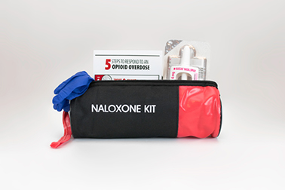
The public health crisis that is the opioid addiction epidemic remains a threat to communities throughout California.In 2017, in an effort to reduce morbidity and mortality associated with opioid overdose, the California Department of Public Health (CDPH) issued a statewide standing order permitting community organizations and other entities to obtain and distribute naloxone (Narcan), a life-saving medication used to reverse an opioid overdose, without a prescription.
A large-scale nationwide study[1] found that states with legislation granting broad access to naloxone reduced opioid overdose mortality by 14 percent. Another study published in the International Journal of Drug Policy[2] found that high rates of naloxone distribution among laypeople and emergency personnel could prevent 21 percent of opioid overdose deaths. The same study concluded that most overdose death reduction is attributable to the increased distribution of naloxone to laypeople and emergency personnel.
“There is little risk associated with supplying naloxone to employees who may come into contact with individuals experiencing an opioid overdose,” said California Joint Powers Insurance Authority (California JPIA) Senior Risk Manager Melaina Francis. “The opioid epidemic public health crisis requires a response such as permitting local government employees to carry naloxone and administer it when necessary. The Authority encourages public agencies to take advantage of the CDPH standing order and ensure a written policy regarding naloxone use is implemented.”
Francis said that the liability exposure for public agencies is minimal because naloxone has no effect if unintentionally administered to an individual without opioids in their system. Also, Good Samaritan and other California laws protect individuals who act in good faith to assist someone experiencing a medical emergency.
Despite this, public agencies should be selective about which employees can carry naloxone. The Authority recommends that public safety, public works, community services, and any other employee who may reasonably come into contact with individuals who are unhoused or experiencing opioid addiction be permitted to carry naloxone.
“In Duarte, we currently permit public safety field officers, including code enforcement, animal control, and outreach coordinators, to carry Narcan and have already experienced success stories with its use,” explained City of Duarte Public Safety Manager Larry Breceda.
Breceda also mentioned that the LA County Sheriff’s Department permits deputies to carry Narcan. He then shared that in November 2022, Temple Station sheriff deputies successfully saved the lives of two unresponsive teenagers suspected of overdosing on fentanyl. The teenagers, who were found in Duarte, were administered Narcan and first aid/CPR.
He also shared details of an event where two transients came into contact with a large amount of fentanyl and overdosed, prompting field officers to administer Narcan to save their lives.
Public agencies, whether currently permitting or exploring the use of naloxone, should develop a written policy. The policy should outline who in the agency is authorized to receive, store, monitor, and distribute naloxone and report on its usage. The policy should also address frequency and documentation of training, appropriate storage, procedures for issuing naloxone to authorized staff, reporting procedures, and sample forms to appropriately document any dose distributed or administered by staff per the CDPH standing order requirements.
The Authority also recommends that a public safety director, human resources, or risk manager be responsible for ensuring that the public agency’s program is and remains compliant once approved and implemented.
To take advantage of the CDPH standing order, public agencies must first apply, then provide training to affected employees. The CDPH offers a training video that can be used to meet this requirement. Local fire departments may also provide training. Francis noted that training should be documented and performed periodically (i.e., every 1-3 years).
Public agencies should also know that obtaining naloxone requires another application through the Naloxone Distribution Project (NDP). This requires a prescription or participation in a standing order through the CDPH.
Public agencies looking for more information on naloxone, the CDPH standing order, or the NDP can visit the California Department of Public Health website.
Providing innovative risk management solutions for its public agency partners for more than 40 years, the California Joint Powers Insurance Authority (California JPIA) is one of the largest municipal self-insurance pools in the state, with more than 120 member cities and other governmental agencies. Members actively participate in shaping the organization to provide important coverage for their operations. The California JPIA provides innovative risk management solutions through a comprehensive portfolio of programs and services, including liability, workers’ compensation, pollution, property, and earthquake coverage, as well as extensive training and loss control services. For more information, please visit the California JPIA’s website at cjpia.org.
References
[1] McClellan, C., et al., Opioid-overdose laws association with opioid use and overdose mortality. Addictive Behaviors, 2018. 86: p. 90-95.
[2] Townsend, T., et al., Cost-effectiveness analysis of alternative naloxone distribution strategies: First responder and lay distribution in the United States. International Journal of Drug Policy, 2019.

